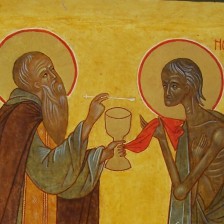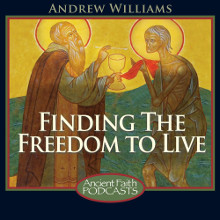
What is the wedding garment that we need to wear at Christ’s great wedding feast, and what does it have to do with the image in iconography and the image in pornography?
We’ve been talking about pornography, and setting it into the context of what I’ve called an “iconographic” way of seeing all of God’s Creation. Last time I suggested we all ask ourselves whether we see God in his creation, or whether we objectify his creation, using it, including other people, for our own purposes. I also suggested that to misuse God’s creation in this way is an act of unfaithfulness, and that unfaithfulness is the characteristic act of immorality. So today I want to delve into this a bit more, particularly, why do I characterize this “non-iconographic” way of seeing specifically as unfaithfulness, and what it is about unfaithfulness that makes me call it the “characteristic act of immorality”.
To talk about unfaithfulness is to talk about marriage. Marriage is absolutely central to our faith. Right from the beginning, from the Creation of humanity as male and female, the Scripture talks about marriage. The relationship between God and Israel in the OT is characterized in terms of marriage. Christ. the Bridegroom of the Church refers specifically to the Genesis passage when he speaks of marriage. St Paul speaks of marriage as a great mystery in terms of the union of Christ and the Church. And the Bible ends with the marriage feast of the Lamb in Revelation.
Every one of us is called to participate in the mystical marriage that is union with God in Christ Share on X
This is not to say that every one of us is called to find a husband or wife. On the contrary, St Paul makes it clear that this is not the case. But every one of us is called to participate in the mystical marriage that is union with God in Christ.
Every time we participate in the Divine Liturgy, we participate in the wedding feast and this wedding feast is at the heart of all the mysteries of the faith. All are called to this marriage. Remember the parable of the wedding banquet — people were called from the highways and byways. But all who were invited were expected to put on a wedding garment. What is this wedding garment? It is a veil that that reveals who I really am just as the Creation as a whole is the veil that reveals who God is. To don the wedding garment is to prepare to participate fully, physically in this union. If you love me, says Christ, keep my commandments. St Gregory of Rome, the Dialogist, says that the wedding garment is a garment of love, woven between the two beams of love for God and love for neighbour — that is, the fulfilment of the law through fully participating in Christ’s wedding banquet.
So the wedding feast is starting. I’m invited. So then why don’t I put on the wedding garment?
Because when it comes down to it, I don’t want to fully participate in the marriage. I don’t really whole-heartedly want what God wants for my life. I want my own way — I want somehow to combine faithfulness to God with the ability to protect myself, to keep my own vulnerability safely hidden… I want to find fulfilment with an easier partner… one who does not and cannot really know me. But this is incompatible with my other, deeper desire… to be truly loved for who I really am.
This is what this marital love and union is about: to know and to be known Share on XAnd this is what this marital love and union is about: it is to know and to be known. Recall the authorized (or “King James”) version of the Bible… “And Adam knew Eve his wife and she conceived.” (Gen. 4:1) This is not a euphemism, it is a deep truth. This physical act of union has to be a manifestation of a spiritual truth. A husband’s love for his wife is to be an image — an icon — of God’s love for mankind, of Christ’s love for his Church. And our love of God is to be as a bride’s love for her bridegroom. We are promised that in the fulfilment of this mystical marriage we will participate in the very life of God — and sexual love in earthly marriage is the most direct physical icon of this ultimate love and union.
This is all part of the iconographic way of seeing; these are simply more details about how Creation is iconic. What we often hear is that Creation teaches us about God — and this is true — but the reality is much deeper than that. Creation not only teaches us, not only reveals God to us, but it allows us — in fact, requires us — to participate in the life of God, either for good or for ill.
The physical and the spiritual are intrinsically connected in Creation and in the human person Share on X
Seeing truly, seeing iconographically is about being in touch with Reality — with God. It means that there is an unbreakable link between what goes on in our bodies, in our minds, and in our souls. The physical and the spiritual are intrinsically connected in Creation and in the human person — which St Maximos the Confessor referred to using the Hellenic concept of microcosm — each human person is a “little cosmos”, an icon of all Creation as well as the image of God.
So to break this iconographic way of seeing is to separate the physical from the spiritual — to objectify the physical, just as using pornography objectifies the person and breaks the link between the physical and spiritual making true relationship impossible. This form of unfaithfulness in using pornography is just one example of the unfaithfulness implicit in using Creation in any context that excludes relating to God.
“When the LORD first spoke through [the Old Testament prophet] Hosea, the LORD said to Hosea, ‘Go, take to yourself a wife of harlotry and have children of harlotry; for the land commits flagrant harlotry, forsaking the LORD.’” (Hos. 1:2). In Hosea, we see that direct link between the physical and the spiritual: Hosea’s marriage to a prostitute is in physical reality an image of the spiritual reality of God’s marriage to unfaithful Israel.
The OT describes the tension between Israel’s love for God and her unfaithfulness to him. Seeking union, but then losing faith and turning from union in order to protect herself. I seek connection and union but at the same time I want to protect my vulnerability — and my inability to truly be vulnerable when it gets too hard prevents the true intimacy I desire. This is also the characteristic of the porn user. It’s the characteristic way of relating for all of us who fail to put on the wedding garment and keep it on always.
When it comes down to it, this non-iconographic way of seeing the world is by nature unfaithfulness. To look at Creation and not see God is like looking at the physical body of a woman and not seeing the fullness of the person. And Jesus said that to look at a woman with lust is to commit adultery in my heart — that is, to be unfaithful.
To look with lust… Lust always means using others to gratify my desires. Even if lust is reciprocated, it’s not love: it’s still seeking my own pleasure — taking another for myself rather than offering myself to another. Even if the lust is for my spouse, the same applies. When St Paul advises those who “burn with lust” to marry, it is not because burning with lust is acceptable in marriage, it is because marriage is a path that can enable us to transform the desire at the root of that lust into something deeper and fuller… something that enables us to see beyond the veil of the physical into deeper spiritual realities… to see iconographically.
Our desires are not too strong, but too weak – C S Lewis Share on XIt’s important to stress again here what I said last time, that the desire here is not something to be killed or suppressed, rather it is something to be transformed. I quoted St John Climacus, “Not he who has kept his clay undefiled is pure, but he who has completely subjected his members to his soul”. C S Lewis points out many times that our desires are not too strong, but too weak. He says, “We are half-hearted creatures, fooling about with drink and sex and ambition when infinite joy is offered us” and that our desires are rather to lead us “to taste at the fountainhead that stream of which even these lower reaches prove so intoxicating”.
So this desire which is at the root of lust is not evil, it is just misdirected, disorientated… it is missing the mark.
And missing the mark, of course, is the definition of sin. The mark is Christ, the true and full human being. Sin is missing Christ… missing the Bridegroom and hitting on something else. So sin by definition is unfaithfulness and specifically, because of our marital union with Christ, sin is marital unfaithfulness. Unfaithfulness, then, is the characteristic act of immorality.
So to briefly summarize: not seeing iconographically is idolatry, which is unfaithfulness in its most obvious, most characteristic sense. Not seeing God in his Creation is not being faithful, not having faith, not trusting him. Pornography is simply one of the most blatant examples of not seeing iconographically specifically in regard to the human person — that is specifically in regard to the image of God. Using pornography, then, is very explicitly showing an inability to be faithful.
Any way of seeing that takes our eye away from God is pornographic Share on X
We often hear the question… why is the Church so bothered about sex? Well, yes — the Church does care about sexual immorality, and this is why… because it goes to the heart of what it is to be made in the image of God, to relate to God… Because what we believe and live out physically and temporarily in this area of our lives is an icon of a deeper spiritual and eternal reality. And in the light of the full, true meaning of marriage we’ve discussed, any way of seeing that takes our eye away from God is pornographic… an obscene writing that obscures rather than reveals the true iconographic nature of created reality.
How can we learn to be faithful? Is unfaithfulness a choice? a compulsion? an enticement? What was it for Eve when she reached out for that fruit in the garden of Eden? The fruit offers us something that we really want, but despite the pleasure it gives, it ultimately fails to live up to the offer — actually it just ends up making us want it more, but also making us even less able to get it. That’s the demonic nature of temptation.
So we know that we are not aiming to close down these desires but to transform them — to look deeper, through the veil, to discern the spiritual reality of what we seek. But what practical steps can I take to achieve this? How can my desires be re-orientated? Next time we’ll start looking at some ways of approaching impulsive, compulsive and addictive behaviours: how to learn to be faithful in the face of that subtle, enticing temptation to miss Christ and hit on something else.


You must be logged in to post a comment.